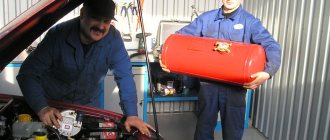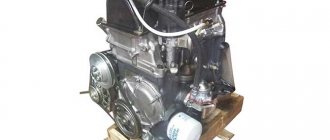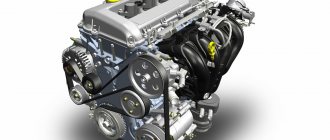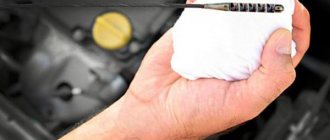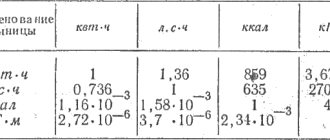For starters, the car blanket test was a near miss. Since mid-December, we had been waiting for the harsh winter promised by weather forecasters, but the severe frosts quickly faded into oblivion, and the Almaty warmth set in in Astana - the thermometer readings ranged from zero to −10 degrees. Finally, in mid-January, the temperature at night began to drop to −18 and below. There will be trials!
We were interested in three measurable parameters - the time the engine cools down overnight, the time it takes to warm up to operating temperature, and heat retention during short stops. To do this, the standard 2008 Suzuki Grand Vitara had to be equipped with a “black box”. An additional 70 A/h battery was installed in the front passenger's feet, and we connected a temperature logger with two temperature sensors to it. One was secured directly to the engine, the second was taken outside. The flight recorder, winking with a blue light, entered new data into a text file on the built-in memory card every minute. We also note that no additional means were used to insulate the motor - no cardboard in front of the radiator, and the crankcase was not even covered with factory protection. The tests lasted for six days, both with and without a blanket.
There are different types of car blankets
In Astana, there were three main types of car blankets for retail sale.
Kazakhstani
Local products are presented in most supermarkets and car markets at a price of 5,500–7,000 tenge. Distinctive features are a plastic bag, into which something that could not be stuffed seemed to be shoved. The blanket itself is covered in a white shiny material and looks well made. The price of a blanket depended both on the place of sale and on its size.
Blankets of different sizes are designed for different cars - everyone's engine compartment is different. Before purchasing, it would be a good idea to measure with a tape measure.
Russian
This collective term came into our search after a survey of car owners in Astana who use blankets. They all bought Russian ones because, in comparison with Kazakh ones, they seemed (according to unclear estimates) better. The price of such blankets is higher on average by 500–1,000 tenge, while Russian products look like ours.
Thin
The third type of blankets was found at car markets; according to sellers, they were made in Russia and Belarus. Nevertheless, they looked the same and differed from the first two in their artisanal packaging and smaller thickness both to the touch and to the eye.
First we bought a Kazakh one, and then, on the recommendation of friends, we bought a Russian one. The latter was accompanied by instructions with a description and copies of certificates. This looked more convincing, and that’s what they put under the hood, although, I repeat, they were tactilely and visually similar.
What about the nightmare?
There is an alternative to a car blanket - you can buy a felt blanket for three or four thousand at any car market in Northern Kazakhstan. It is sold for exactly the same purpose - to insulate the engine.
Let's assume that natural insulation copes with its task to some extent. However, there is a small but. It is almost impossible to completely get rid of the smell of sheep from felt. It may not smell when it is cold, but when it warms up... But warm air from the engine compartment enters the air intakes of the cabin. In general, we didn’t even consider the felt, although we had it for comparison.
Additional use of insulation
Drivers insulate not only the engine, but also other components and mechanisms. We are most often talking about radiators, batteries, and the interior. Let's look at each point in more detail.
Cooling radiator insulation
The use of various raw materials is envisaged:
- cardboard;
- felt;
- leatherette.
The main thing is that the protection can be removed conveniently and quickly. This is of great importance when working with gasoline engines. If you do not release the device from protection in time, you can cause it to overheat. The hygroscopicity of the components used plays a significant role. They should absorb moisture well. Otherwise, you will not be able to maintain your original characteristics.
Modern vehicles are designed in such a way that it is quite difficult, and sometimes impossible, to attach home-made insulation to the radiator grille. Therefore, it is better to purchase the factory version.
Battery insulation
The manufacturing materials are similar to those used for the production of car blankets. They are not afraid of electrolyte, oil and other aggressive liquids. It is worth remembering that it is necessary to warm the battery only in extreme cases, when there is severe frost outside. Mainly large structures are insulated. If we are talking about small batteries, then it is easier to remove them and take them home to recharge.
If it is relatively warm outside, then excess insulation can lead to an explosion of the battery. There is no need to bring the situation to an emergency. This is fraught with problems both for the vehicle and for human health. You can make battery insulation yourself, or you can purchase it at retail outlets. The main thing is that the outer layer is non-flammable, without foil, to avoid short circuits.
Insulation of the interior
In addition to insulating the engine compartment, many drivers try to keep the interior warm. And it doesn’t matter whether the car is domestic or foreign. The main thing is to make people’s stay in the car more comfortable. For the interior it is necessary to choose high-quality insulation. It should be with additional sound insulation so that the passengers present enjoy the trip. The most common components are polyurethane foam, polyethylene foam and penofol.
Polyurethane foam copes well with cold and excess noise. If you completely cover the body with it, the effect will be amazing. It covers all the cracks and prevents frosty air from penetrating inside. Thermal conductivity is low. Prevents metal damage by corrosion. Completely safe for health. You won't be able to do the work yourself. To apply polyurethane, you need to have special equipment, which is very expensive (more than 10,000 rubles). It is better to entrust this matter to professionals.
Penofol is the same polyethylene, only aluminum foil is used instead of the top layer. A distinctive feature of the raw material is its cold-reflecting effect and powerful sound insulation. The thickness is several millimeters. It is enough to use one layer. The advantages of the material include ease of installation, durability, light weight, and flexibility. After pasting, the heat remains much longer.
How we tested
The first measurements began outside the city, on a cold and windswept lake in the southwest of Astana, during the first stage of the Samuryk rally sprint, which lasted from early morning until late evening. The thermometer outside during the day showed an optimistic -12, but the strong wind penetrated to the bones. The car cooled down quickly in such conditions.
By the way, during tests outside the city, something happened to the engine: it suddenly began to shut down at four thousand rpm, and this was in a lower gear. The check light came on. Wondering what it was that I tore off, rolling around in the snowdrifts, I lifted the hood and saw how the air intake was trying to eat the blanket. Careless packing of the blanket resulted in the edge being sucked in. Pay attention to this. The check went out only the next day.
When laying the car blanket, pay attention to possible contact with moving parts (hood lock, fan, pulleys, drives). Do not cover the air intake of the intake system with it.
We decided to continue testing until we obtain data suitable for comparison. Fortunately, the anticyclone stayed over Astana for a week.
There was no need to particularly simulate typical situations from the everyday life of a car owner. The length of the overnight stay was at least 10 hours. In the morning, as usual, I started the engine and started driving in about 5-6 minutes without warming up on the spot. After 15–20 minutes, I stopped the engine near the office, after which the car cooled down for at least 4 hours, and sometimes more. The ragged schedule of short trips and stops developed naturally in the afternoon.
During the testing period, we took out the flash drive several times to check the operation of the logger - it worked properly. By the end of the week, all that remains is to download the data, divide it into periods for comparison, and build a graph. Suffice it to say that it was long and tedious, but in the end we got a result suitable for study.
Does not burn? What if we light it?
The instructions say that the available operating mode is up to +600 degrees. What if it's higher? Will it flare up? This temperature does not exist under the hood of a passenger car unless the blanket is in direct contact with the exhaust manifold, the temperature of which can reach 800 degrees, or even higher. Our test will turn out to be even hotter - let's try to set fire to the blanket with a gas torch.
According to reference books, the temperature at the tip of the flame is approximately 1,500 degrees. Yes, our roasting will exceed the manufacturer’s warning, but this way we will make sure how stable the material is and whether it will ignite under the influence of an open flame.
The fabric of the blanket trembled from contact with the fire, but did not give in immediately. After a few seconds it began to melt, a small hole formed on it, through which you could see how the filler was smoldering. Everything stopped instantly as soon as we turned off the burner.
The car blanket did not catch fire. The covering tissue in the place of heating melted, the edge of the hole became brittle, the material crumbled like glass, which is understandable - it is fiberglass. The interior did not catch fire either - mineral wool (most likely ordinary glass wool). It was charred, but did not burn. It is worth recognizing that a car blanket will become one of the most heat-resistant elements in the engine compartment of a car, rivaling unpainted metal parts.
Disadvantages of internal combustion engine insulation
A car blanket, as a product for protecting the engine, has both supporters and opponents of its use. Among the main disadvantages, car owners name:
- Clogging of the engine compartment with microparticles of fiberglass and other components of the blanket.
- There is a possibility of the blanket detaching, with the danger of it getting into the moving elements of the engine compartment with all the ensuing consequences.
- Possibility of ignition of insulation when the engine heats up too much.
All the described disadvantages from a practical point of view are significant, however, in most cases they are explained by the irrational choice of a car blanket of inappropriate quality from an inexpensive product category.
When choosing a blanket for a car engine, it is important to take a rational approach to studying its composition and technological features, and give preference to purchasing insulation exclusively in certified stores. The correct approach to product selection will allow you to avoid unpleasant precedents during its operation.
Results of our tests
The bad news for comfort lovers is that a warm engine cools down the same way, whether with or without a blanket. At an average temperature of −12 during the day in the city, after 30 minutes of parking, the engine temperature drops to about 50 degrees; in this situation, warm air will blow from the stove. After 60 minutes of parking, the temperature drops to 38 degrees. Upon returning from the supermarket, the car will already be cold, both with and without a blanket.
But long-term overnight parking revealed one positive effect from using a car blanket. Over three hours of parking, the temperature dropped almost equally with and without a blanket: with a car blanket, the temperature under the hood dropped to 12 degrees after 182 minutes, without a blanket - after 177. But then the insulation made itself felt: the temperature dropped to zero degrees without a blanket after 305 minutes (5 hours and 5 minutes), and during the same time the engine covered with a blanket showed 4 degrees above zero and cooled to zero in 339 minutes (5 hours 39 minutes). Winning in 34 minutes! Although after 8 hours of parking in both cases the engine cooled down to street temperature. Considering that the car usually sits for more than 10 hours from evening to morning, we did not find any benefit from the insulation. By the way, in our case, the street temperature at night dropped to −20 degrees. What if it’s −40? In such frosts, the engine will cool down even faster.
Engine cooling time at night. January, 2021. Average night temperature -14.6 °C
The blanket showed itself during the morning warm-up. If without it the engine warmed up to operating temperature in an average of 21 minutes, then with a blanket it took 16! Bingo! The only pity is that I drive about 20 minutes to work, and it doesn’t matter whether it’s 90 degrees under the hood or 80. The stove was just starting to warm up the interior when it was time for me to get out.
Warm-up time to operating temperature. January, 2021. Average morning temperature -13 °C
Another bonus is that the blanket keeps the hood from heating up. Falling snow does not melt on it, which ultimately prevents the formation of a crust of ice.
Observations, myths and their destruction
The wind changes everything. The success of our experiment was greatly helped by calm weather, which lasted almost the entire time while the measurements were being made. But at the beginning of the period it was not so. We had to abandon the measurements recorded in windy weather because the car cooled down faster and the car blanket had no effect on this process. But they made an interesting observation: without wind, even after 10 hours under the hood it was a couple of degrees warmer than the surrounding air. But with the wind, the engine cools down to ambient temperature (despite the fact that on windy days it was -12) in 7 hours 35 minutes.
You can say a few words about the sound insulation that the car blanket supposedly contributes to. Outside - yes. The ears catch the difference with and without a blanket. But in the salon - no. And what’s the point of talking about silence when the stove hums at high speeds, warming up the cooled interior?
They say that the car blanket has a negative effect on parts made of plastic, rubber, as well as on the insulation of wires: supposedly due to high heat, the materials dry out and their service life is reduced. Well, we checked this. In fact, directly under the blanket in winter the temperature ranges from 60 to 85 degrees, this temperature is absolutely harmless. In the summer heat in the sun it is much hotter under the hood!
Let’s add one more conclusion: you can mostly find white blankets on sale. This, of course, is beautiful, but only at first. A little later, when touched with parts of different cleanliness, it quickly loses its luster and cannot be washed. In general, there are black coatings, but we have not seen such ones.
FAQ
Let's look at the most common questions that car enthusiasts have when choosing a car blanket:
- Could a car blanket get stuck somewhere under the hood? No, since the insulation is made of dense material that simply cannot wrap around the timing belt. Thanks to the appropriate patterns that are used to create blankets, the products are held tightly above the motor.
- How does a car blanket handle washing? Experts and experienced car enthusiasts advise not to wash insulation. The fact is that it is very difficult to dry any car blanket; in addition, you risk damaging its shell. Therefore, it is better to get rid of stains using the dry cleaning method. Dirt does not in any way affect the thermal insulation properties of the material.
- How can you keep warmer? To do this, you can use plastic plugs that must be installed on the radiator grille. Regular cardboard is also suitable for these purposes.
When choosing an “Avtotepl” car blanket, it is important to determine exactly which model is suitable for your vehicle.
Should I buy myself a blanket?
A blanket alone is not enough to keep you warm. When insulating the engine compartment, you need to at least have standard protection from below, and also hang a curtain or insert cardboard in front of the radiator. Then there will be an effect. The same is reported by drivers who use a blanket in cold regions, from Northern Kazakhstan to Yamal.
You can say it another way. Under the conditions in which we tested the car blanket, which is a temperature from −10 during the day to −20 degrees at night, there is definitely no urgent need for it. There is also no need for additional protection of the engine compartment on the test vehicle. Without all this, my Grand Vitara starts up regularly in the morning, and a 5-minute difference when warming up doesn't really matter to me. I wouldn't buy it. There is another option, the absence of which you acutely regret at temperatures from zero and below. But this is not a car blanket, not a crankcase burner, or even a Webasto. This is... heated seats.
In the meantime, the car blanket has been registered under the hood and is awaiting the next stage of testing in Astana. We will connect the logger again if the temperature drops below minus 30 for a week. They say that under such conditions, a car whose alarm is configured to autostart based on engine temperature starts one or two times less often overnight. Perhaps this will be a different story.
What types of insulation are there?
Problems with engines occur mainly among residents of cold regions. Severe frosts are a test not only for people, but also for equipment whose components and mechanisms fail. Destruction does not occur instantly, but gradually. Only insulation will help solve the problem. The best devices for these purposes are:
We recommend: DIY installation of a universal headlight washer
Type Description
| Autonomous start and warm-up system | Allows you to remotely warm up the engine. If the system is installed incorrectly using the remote control, the car may start and move on its own. |
| Radiator shutter | An old but effective way to quickly start a car in severe frost. The principle of operation is to block the main element of the cooling system. At the same time, the engine cools down slowly. If you do not remove the damper in time, the engine may boil. The method is used when the temperature drops below 10 degrees below zero. |
| DIY motor insulation | It is made from available components: felt, isolon, foil synthetic film. Stows under the hood. |
| Auto blanket | It is considered the most effective and practical device. The characteristics resemble mineral wool, however, it is made of a metal-containing alloy. |

